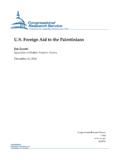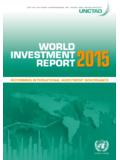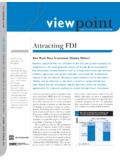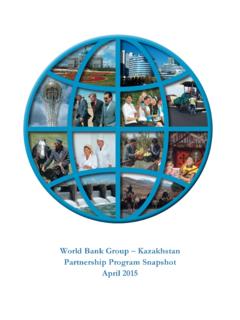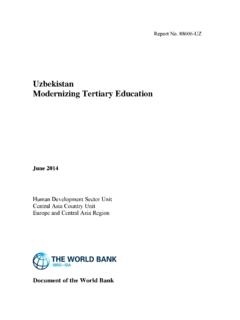Transcription of China-U.S. Trade Issues
1 Trade Issues Wayne M. Morrison Specialist in Asian Trade and Finance January 23, 2018. Congressional Research Service 7-5700. RL33536. Trade Issues Summary economic ties have expanded substantially since China began reforming its economy and liberalizing its Trade regime in the late 1970s. Total merchandise Trade rose from $2 billion in 1979 (when China's economic reforms began) to an estimated $633 billion in 2017. China is currently the United States' largest merchandise trading partner, its third-largest export market, and its biggest source of imports. In 2015, sales by foreign affiliates in China totaled $482 billion. Many firms view participation in China's market as critical to their global competitiveness. General Motors (GM), for example, has invested heavily in China, selling more cars there than in the United States annually from 2010 to 2017. In addition, imports of lower-cost goods from China greatly benefit consumers. firms that use China as the final point of assembly for their products, or use Chinese-made inputs for production in the United States, are usually able to lower costs.
2 China is also the largest foreign holder of Treasury securities (at $ trillion as of October 2017). China's purchases of debt securities help keep interest rates low. Despite growing commercial ties, the bilateral economic relationship has become increasingly complex and often fraught with tension. From the perspective, many Trade tensions stem from China's incomplete transition to a free market economy. While China has significantly liberalized it's economic and Trade regimes over the past three decades, it continues to maintain (or has recently imposed) a number of state-directed policies that appear to distort Trade and investment flows. Major areas of concern expressed by policymakers and stakeholders include China's alleged widespread cyber economic espionage against firms; relatively ineffective record of enforcing intellectual property rights (IPR); discriminatory innovation policies; mixed record on implementing its World Trade Organization (WTO) obligations;. extensive use of industrial policies (such as subsidies and Trade and investment barriers) to promote and protect industries favored by the government; and interventionist policies to influence the value of its currency.
3 Many policymakers argue that such policies adversely impact economic interests and have contributed to job losses in some sectors. The Trump Administration has pledged to take a more aggressive stance to reduce bilateral Trade deficits, enforce Trade laws and agreements, and promote free and fair Trade , . including in regards to China. In March 2017, President Trump issued an executive order mandating an Omnibus Report on Significant Trade Deficits (China accounts for the largest bilateral Trade imbalance, estimated at $371 billion in 2017). In April 2017, he ordered Section 232 investigations into the national security implications of imports of steel and aluminum (China is the world's largest producer of these commodities). In May 2017, the United States and China announced outcomes of a special 100-day plan on Trade , (an initiative that was agreed to by President Trump and Chinese President Xi at their April 2017 meeting), including market access commitments by China on beef, biotechnology products, credit rating services, electronic payment services, and bond underwriting and settlement.
4 Also in May, the two sides held their first session of the newly-created Comprehensive Dialogue, but with no announced progress on commercial Issues . In August 2017, the Trade Representative (USTR) announced the initiation of a Section 301 investigation of China's IPR policies and technology transfer requirements. In November 2017, President Trump traveled to China, where he announced the signing of $250 billion in commercial deals between and Chinese firms, and stated that he did not blame China for the large Trade imbalance, but rather, previous administrations. This report provides background and analysis of commercial ties, including history, trends, Issues , and outlook. Congressional Research Service Trade Issues Contents Introduction .. 1. Most Recent Developments .. 1. Trade with China .. 2. Merchandise Exports to China .. 3. Major Merchandise Imports from China .. 7. Trade in Services .. 8. The Merchandise Trade Deficit with China .. 9. The Transfer of Pacific Rim Production to China by Multinational Firms.
5 11. China as a Major Center for Global Supply Chains .. 12. Jobs and Trade .. 16. Investment Ties: Overview .. 18. China's Holdings of Public and Private 19. Residential Real Estate .. 21. Bilateral Foreign Direct Investment Flows .. 21. Alternative Measurements of Bilateral FDI Flows .. 22. Chinese Restrictions on FDI in China .. 26. Negotiations for a Bilateral Investment Treaty (BIT) .. 26. Major Trade Issues .. 29. Chinese State Capitalism .. 31. China's Plan to Modernize the Economy and Promote Indigenous Innovation .. 34. New Restrictions on Information and Communications Technology .. 37. Intellectual Property Rights (IPR) Issues .. 40. Technology Transfer Issues .. 44. Cyber-security Issues .. 45. China's Obligations in the World Trade Organization .. 49. WTO Implementation Issues .. 50. China's Currency Policy .. 55. The Trump's Administration's Approach to Commercial Relations with China .. 58. Concluding Observations .. 60. Figures Figure 1. Top 5 Merchandise Export Markets in 2016.
6 4. Figure 2. Major Sources of Merchandise Imports: 2016 .. 7. Figure 3. Major Services Trading Partners in 2016 .. 9. Figure 4. Merchandise Trade Balance with China: 2000-2016 and Projection for 2017* .. 10. Figure 5. Five Largest Merchandise Trade Imbalances in 2017* .. 10. Figure 6. Manufactured Imports from Pacific Rim Countries as a Percentage of Total Manufactured Imports: 1990 and 2016 ..11. Figure 7. Manufactured Imports from China and Japan as a Percentage of Total: 1990-2016 (%) .. 12. Figure 8. Computer Imports from China as a Percentage of Total Computer Imports: 2000-2015 .. 13. Congressional Research Service Trade Issues Figure 9. Estimated Percentage Foreign Value-Added to China's Exports in 2011 .. 14. Figure 10. Two Measurements of Trade in Goods and Services: 2011 .. 14. Figure 11. Top Five Country Sources of Facilities that Supply Apple Corporation in 2015 .. 16. Figure 12. China's Holdings of Treasury Securities: 2002-October 2017 .. 20. Figure 13. Sales by Foreign Affiliates of Firms by Country.
7 22. Figure 14. BEA and RG Estimates of the Stock of FDI through 2016 .. 24. Figure 15. BEA and RG Data on Annual FDI Flows to China: 2005-2016 .. 24. Figure 16. BEA and RG Data on Chinese FDI Flows to the United States: 2005-2016 .. 25. Figure 17. China and Simple Average MFN Tariff Rates .. 50. Figure 18. RMB-Dollar Exchange Rates: January 2015 to December 2017 .. 57. Tables Table 1. Merchandise Trade with China: 1980-2016 and 2017 Projections .. 3. Table 2. Major Exports to China in 2016 .. 4. Table 3. Major Merchandise Export Markets: 2001-2016 .. 5. Table 4. Major Merchandise Imports From China in 2016 .. 8. Table 5. China's Holdings of Treasury Securities: 2002-October 2017 .. 20. Table 6. Summary of BEA Data on FDI Flows: 2016 .. 22. Table 7. Top 10 Chinese Investments in the United States: 2005-June 2017 .. 25. Table 8. Top 20 Chinese Companies on Fortune's Global 500 in 2017 .. 33. Table 9. Summaries of WTO Dispute Settlement Cases Against China .. 54. Appendixes Appendix.
8 Chinese Policies to Boost Innovation .. 63. Contacts Author Contact Information .. 71. Acknowledgments .. 71. Congressional Research Service Trade Issues Introduction Economic and Trade reforms begun in 1979 have helped transform China into one of the world's biggest and fastest-growing economies. China's economic growth and Trade liberalization, including comprehensive Trade commitments made upon its entry to the World Trade Organization (WTO) in 2001, have led to a sharp expansion in commercial ties. Yet, bilateral Trade relations have become increasingly strained in recent years over a number of Issues , including China's: mixed record on implementing its WTO obligations; infringement of intellectual property (such as through cyber theft of Trade secrets and forced technology requirements placed on foreign firms); increased use of industrial policies to promote and protect domestic Chinese firms; extensive Trade and foreign investment restrictions; lack of transparency in Trade rules and regulations; distortionary economic policies that have led to overcapacity in several industries; and its large merchandise Trade surplus with the United States.
9 China's economic and Trade conditions, policies, and acts have a significant impact on the economy as whole as well as specific sectors and thus have been of concern to Congress. This report provides an overview of commercial ties, identifies major Issues of contention, describes the Trump Administration's Trade policies toward China, and reviews possible outcomes. Most Recent Developments commercial ties are increasingly complex and at times contentious, as reflected in the recent developments summarized below. On December 12, 2017, in an apparent reference to China, the Trade ministers of the United States, European Union, and Japan at the WTO issued a joint statement expressing concerns over severe excess capacity in key sectors exacerbated by government-financed and supported capacity expansion, unfair competitive conditions caused by large market-distorting subsidies and state owned enterprises, forced technology transfer, and local content requirements and preferences; and they further stated that such polices are serious concerns for the proper functioning of international Trade , the creation of innovative technologies and the sustainable growth of the global economy.
10 The three countries pledged to enhance cooperation to eliminate these practices. On November 28, 2017, the Department of Commerce announced the self- initiation of antidumping duty (AD) and countervailing duty (CVD). investigations of imports of common alloy aluminum sheet from China the first self-initiated investigation by Commerce since 1985. From November 8-10, 2017, President Trump made a state visit to China. He announced that and Chinese firms had signed commercial deals worth more than $250 billion. According to a White House press release, President Trump told Chinese President Xi Jinping that his administration was working to make commercial ties with China a fair and reciprocal one. Trump mentioned the Trade deficit with China, and said that the two sides needed to immediately address the unfair Trade practices that drive this deficit, along with barriers to market success. He further stated that he did not blame the very unfair and Congressional Research Service 1.









